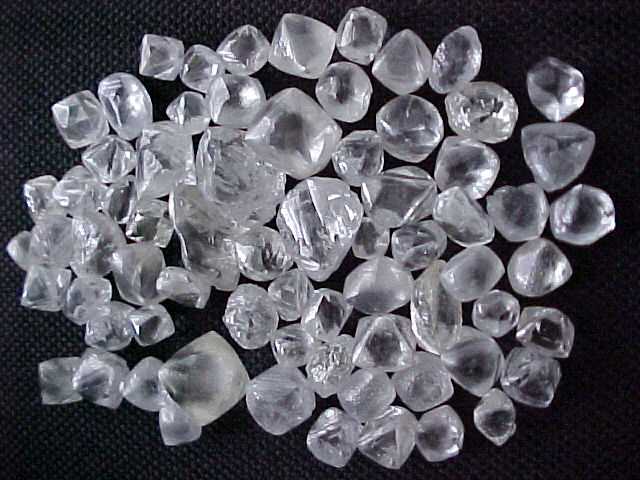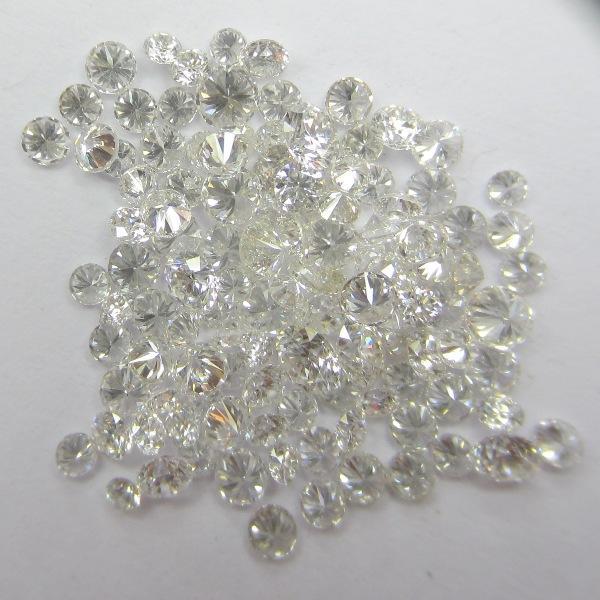
Parcel of rough diamonds
A lot has been said about diamonds over the years, both positive and negative. In the spirit of inclusiveness, here’s a quick rundown. Diamonds are beautiful, perfectly suited for use in jewelry, and every single natural diamond is unique to itself no matter what detractors may say. Diamond as a material substance represents the extremes of several physical characteristics: melting point, tensile strength, compressive strength, hardness, thermal conductivity, diaphaneity, and lattice density, all of which lend to the beauty and durability of diamonds. They are the perfect jewelry stone. While not rare en masse, gem-grade diamonds make up scarcely 20% of all diamond rough that is mined worldwide.
But there’s also no getting around the other side of things, so let’s talk about it. Like all gemstones of significant value since Antiquity, diamonds have been found in places of the world where they are mined and used to fund some violent and otherwise unsavory actions. So-called “blood” or “conflict” diamonds were such a problem that the United Nations finally stepped in.
As a result, diamonds are more closely policed than any other gemstone, and the UN has sanctions in place for screening the sale of both diamond rough and cut gems before they reach the open market. While conflict diamonds are a genuine concern to the diamond economy, the UN’s certification system, called the Kimberley Process, has been largely successful at keeping conflict diamonds out of the international trade scene by tracing and refusing the sale of diamond rough from countries who cannot verify the source of their diamonds or to where the money obtained through the sale of diamond rough goes. The diamonds I get are protected by the Kimberley Process, and so you can enjoy your diamond, confident of its ethical origins.

Parcel of faceted round briliant diamonds
While I can get you any grade of diamond you desire, I tend to carry whiter, cleaner stones. I also specialize in diamonds that are considered “ideal cuts.” In technical terms, that means the polish of the facets is so unblemished that more light enters the stone, and the facets of the diamond are perfectly proportioned and angled to one another so as to maximize the way light interacts with the diamond and returns to the eye. In practice, that means you can see an ideal cut diamond sparkling in a dark corner from the other side of a room. I’m happy to demonstrate the coolness of that effect for you, as well.
Whether it’s a true colorless ideal cut that flashes with all the colors of the rainbow, or an extra high-clarity emerald cut that shimmers with brilliant bars of light, traditional diamonds are fascinating in both their aesthetics and science.
Then there’s the world of fancy colored diamonds. Many colored diamonds get their hues from an irradiation process, but vivid brown, yellow, orange, pink, blue, green, purple, and red (27 hues in all, according to GIA) have all been found naturally. Canary yellow, steely blue, chocolate brown, and baby pink are very popular. Shades of orange, green, and purple are less often encountered because of their rarity, but they do occur.
Natural gem-grade reds are the rarest color. Perhaps as many as a few dozen have been discovered and officially graded as fancy red in the last fifty years, and of those, only a handful have been deemed pure red with no secondary or modifying hue.
If you have more questions about diamonds, by all means, stop in to see me. Whether it’s for an engagement ring, a diamond pendant, a pair of diamond earrings, or anything else you might want to put some diamonds in, my staff and I would love to share our knowledge and show you my collection. Ask us about customizing a special piece of jewelry just for you or someone you love for their April birthday, or for any occasion; ask us why diamonds aren’t – as some people may say – “just boring diamonds.” There are plenty of reasons why diamonds are the ideal jewelry stone and being blasé isn’t one of them.
Tags: April Birthstone, diamonds, facets, gemstones, jewelry, Kimberley Process, love, United Nations